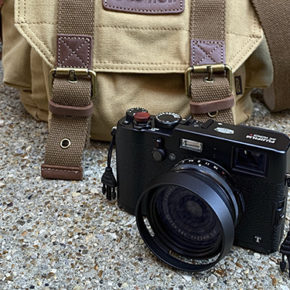The Power To Deliver
I remember when, back in the days of film (you remember film, right?!), a photographer could run out of camera battery power and still continue to shoot pictures.
There was no technical wizardry involved, other than a sound understanding of one’s kit and the basics of recording light onto film. No, the ability to continue shooting came thanks to the mechanical nature of those cameras.
Typically, at the point when your battery expired, you’d switch to ‘flash sync’ mode (which gave a shutter speed of 1/125th second) and, with your understanding of which aperture would be required to correctly expose the scene in conjunction with that shutter speed, you’d turn the aperture ring accordingly.
It was a brilliant fall-back feature, and one which I sometimes long for on occasions where I think there’s a chance I might get caught out.
Yes, I always carry spare camera batteries (and chargers), but they are not absolutely bombproof (cold weather on location being a typical culprit in their sudden demise at the most inopportune of moments).
But as cameras have evolved, along with the almost complete domination of polycarbonate body construction, surely you have to think that maybe us photographers are now missing out? The mechanical has given way to the electronic, to the point where it can seem like our pictures are taken by mini computers rather than light-capturing boxes.
When it comes to smaller batteries (and I’m thinking specifically of the AA variety here), my day-to-day kit and approach to power has actually benefited from the advances in technology.
It’s been quite some years since I last purchased any non-rechargeable AA batteries to power items such as flash guns, audio recorders, accessories etc.
Much aside from the environmental benefits (always good), as a working photographer who has enough expense going out every month, I can honestly say that the switch to rechargeables was one of the smartest moves I ever made.
A few months back, I finally had to put in an order for some new AAs. How long had the previous set lasted, before they began failing to hold their charge correctly? About four or five years of constant use.
Things have a habit of moving on at quite a pace, and I’m always pleased to see just how much higher the capacity of the replacement batteries is! As a bonus, it’s also nice to know that I can still use the same fast chargers for these new versions.
Battery choice for photographers is another one of those ‘no-brainer’ decisions, as far as I’m concerned. Ok, so there are occasions when rechargeables can have a bit of a hiccup, but that’s why I always carry plenty more than I know I’ll need on any given job.
As I see it, it’s simple: the environment benefits, my pocket benefits and the success of my day-to-day photography has much higher odds when I take the guess-work out of the equation.
Where do you stand on the battery debate? Have you moved with the times, or is there a good reason why you stick with the older method of disposable batteries? As ever, I’d be interested to hear your thoughts.
Category: Location photography, Technique












Completely agree, it’s rechargeable for me every time. I can’t understand that with today’s technology why ‘standard’ cells are still available.